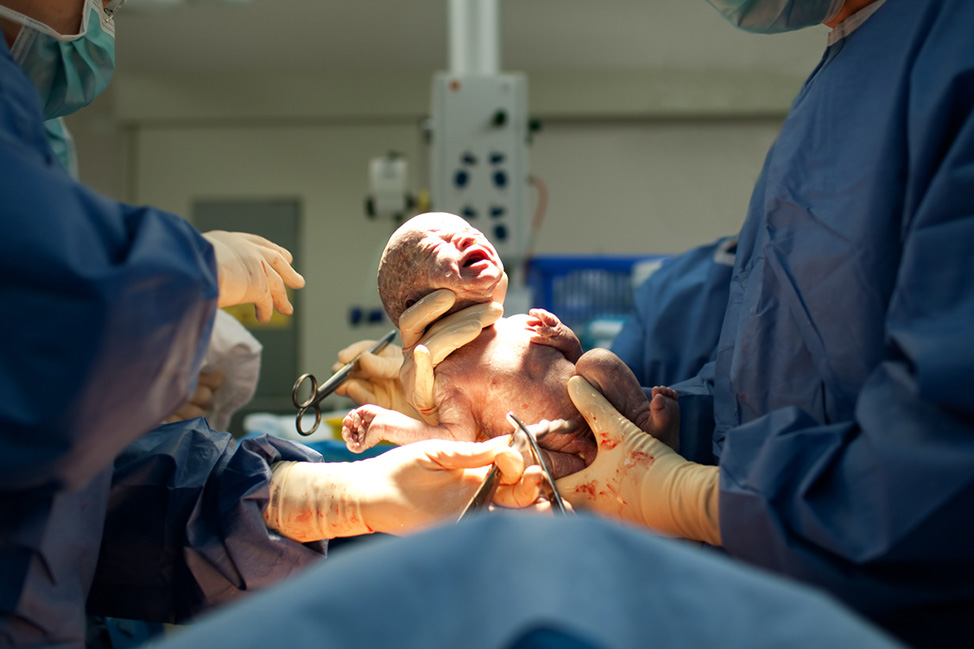
Why Cesareans are Prevalent Despite Increased Risk of Complications

Cesarean Section is a type of abdominal surgery used for delivering a baby. It is the method of delivery in roughly one-third of pregnancies in the United States (32 % in 2015). The rate of cesarean section grew steadily from 22.7% in 1990 to a peak in 2009 of 32.9%.[1] Although the risks from cesarean section are low, they are higher than with a normal vaginal delivery.[2] Complications associated with a C-section include hemorrhage, infection, injury to abdominal organs, hysterectomy, the risk of maternal or fetal death, as well as effects on future pregnancies, such as placental abnormalities and preterm birth. Because of these complications, C-sections directly contribute to the increasing maternal death rate in the United States — a death rate that is higher than Kazahkstan, Croatia, Bosnia and Herzegovina.[3]
Some of the factors contributing to the prevalence of C-section delivery are discussed below.
ELECTIVE CESAREAN SECTION (CESAREAN ON MATERNAL REQUEST)
Some women desire to avoid vaginal delivery and elect a C-section for delivery. There are arguments both for and against elective C-section. Patients interested in this should speak with their health care professional about the risks and benefits of elective C-section.
The risks from a cesarean are higher than with a normal vaginal delivery; however, the complication rate of a scheduled primary cesarean section is very low.[4] If the woman is not planning on any future children, then the total complication rate approaches that of a vaginal delivery, and there are some potential benefits of planned cesarean delivery:
Lowering of the rate of unplanned cesarean section
Since complications are more frequent in the unplanned cesarean section, planning an elective cesarean would lower this complication risk.
Reduction in some neonatal disorders that could be due to the birth process
Shoulder dystocia is one example. A shoulder dystocia is when the baby’s head delivers, but the body gets stuck at the shoulders. This can be a life-threatening event and is much less likely to occur when a cesarean section is performed.
Reduction in pelvic floor injury
Some evidence suggests that performing a C-section prior to labor may decrease the incidence of urinary and fecal incontinence as well as pelvic organ prolapse. This relationship is not well-defined, though, and the data that exists is not of high quality.[5]
VAGINAL BIRTH AFTER CESAREAN (VBAC) VS. REPEAT C-SECTION
VBAC is when a woman who has had a previous C-section has a vaginal delivery in a subsequent pregnancy. There are many factors to consider when deciding whether to pursue VBAC:
Is it safe?
The safety of VBAC depends largely on the type of incision on a woman’s uterus. The greatest fear of trial of labor after cesarean (TOLAC) is that of uterine rupture. Uterine rupture is when the scar on the uterus separates, endangering the life of mother and baby. In general there are two types of incisions that are used on the uterus in a cesarean delivery. The most common type of incision on the uterus is in an area that does not actively contract during labor. These have a low incidence of uterine rupture and are generally considered safe for TOLAC.[6] On the other hand, incisions placed higher on the uterus—which are only used in special circumstances– are in an area that contracts more during labor and have a higher incidence of uterine rupture. Patients with these types of previous C-sections are advised to have a repeat C-section rather than attempt VBAC. The type of incision visible on a woman’s skin has nothing to do with the type of scar that is on her uterus.
What is the chance of successful VBAC?
This depends on the mother’s previous birth history, the reason for the first cesarean section, whether labor occurs spontaneously or is induced, and maternal/fetal medical conditions. A woman who has previously had a vaginal delivery has a higher chance of success than one who has not. A woman who had her cesarean because the baby was breech has a higher chance of having a successful VBAC than a mother who had her C-section because her cervix stopped dilating.[7]
How many more children are planned?
The more C-sections a patient has had, the higher the chance of complications for both her and her baby. Because each C-section increases risks exponentially, a woman who desires to have more children after a given delivery may benefit by having a successful VBAC. Many physicians recommend repeat C-sections if a woman has had two or more previous C-sections.
How does recovery time and risk of each compare?
Recovery time and risk after vaginal delivery is lower than after C-section.[8] Recovery time and risk after planned C-section is lower than after unplanned C-section.[9] The best case scenario is to have a successful vaginal delivery. The worst case scenario is to attempt to have a vaginal delivery and then need a C-section after many hours of labor. Somewhere between these is the scheduled repeat C-section.[10]
CONTINUOUS ELECTRONIC FETAL MONITORING (EFM)
Continuous electronic fetal monitoring is when an electronic device is attached to the mother or baby and provides a continuous tracing of the fetal heart rate and uterine contraction pattern. Although there has been little data to show improved long-term outcomes in the uncomplicated patient, most experts agree that it has increased the occurrence of cesarean delivery. Why is it used? It is far less resource-intensive to successfully monitor the fetal heart rate with continuous monitoring than listening intermittently. There is also some limited evidence that suggests a lowering in the incidence of neonatal seizure.[11]
There are certain characteristics of the fetal heart rate tracing that help predict if a baby is, or is not, receiving adequate oxygen during labor. While it is reliable at predicting which babies are receiving adequate oxygenation, it has a low ability to accurately predict those that are receiving inadequate oxygenation.[12] This means that when a fetal heart rate tracing has certain findings, they may be interpreted as a chance that harm may eventually come to the baby if labor is allowed to continue. And in some circumstances, this is correct, but not all.
It is important to note that the majority of studies that looked at the outcomes of EFM were conducted in uncomplicated pregnancies. It is very likely that EFM does improve the outcome of pregnancies that are complicated by medical conditions such as diabetes or hypertension.
Countering the Prevalence
The safety measure most commonly used to evaluate the rate of cesareans is the primary C-section rate — that is, the number of first C-sections. The primary cesarean is considered to be the most significant measure because the primary C-section is the most preventable one. If the primary cesarean rate can be lowered, the total rate would decrease not only by the number of primary C-sections avoided, but also by the number of related future C-sections that would not occur.
In 2015, the primary C-section rate reported by Seton Healthcare Family was 27.7 percent for the network with Seton’s main delivery site reporting 23.6 percent—both lower than the overall Texas reported rate of 29 percent.[*]
To further reduce risks to mothers and babies, Seton Healthcare Family is working to counter the rates of C-section. A Seton policy released in 2015 focuses on limiting elective induction of labor in women who have a higher chance of needing a cesarean section based on the findings of their cervical exam. If labor is induced in a woman whose cervix isn’t “ripe,” she has a higher chance of delivering by cesarean section. This policy requires that the cervix be ripe prior to elective induction of labor.
Seton also is working to better recognize and respond to findings on the fetal heart rate tracing. By using a standardized approach to the interpretation and response to these findings, we can learn from their outcomes and improve our practice.
More information on this important topic can be found in the article linked here: “Preventing the First Cesarean Delivery: Summary of a Joint Eunice Kennedy Shriver National Institute of Child Health and Human Development, Society for Maternal-Fetal Medicine, and American College of Obstetricians and Gynecologists Workshop.”
[1]https://www.cdc.gov/nchs/data/nvsr/nvsr63/nvsr63_06.pdf
https://www.cdc.gov/nchs/data/nvsr/nvsr66/nvsr66_01.pdf
https://www.cdc.gov/nchs/fastats/delivery.htm
[2]https://www.ncbi.nlm.nih.gov/pubmed/21833896
[3]http://data.unicef.org/topic/maternal-health/maternal-mortality/
[4]https://www.ncbi.nlm.nih.gov/pubmed/20583935
[5]https://www.ncbi.nlm.nih.gov/pubmed/17513936
[6]https://www.ncbi.nlm.nih.gov/pubmed/20664418
[7]https://www.ncbi.nlm.nih.gov/pubmed/10831991
[11]https://www.ncbi.nlm.nih.gov/pubmed/28157275
[12]https://www.ncbi.nlm.nih.gov/pubmed/25389019
[*] The most commonly used statistical reporting method that is related to the primary C-section rate is the NTSV which stands for “nulliparous women with a term, singleton baby in a vertex position delivered by cesarean birth.” This rate excludes some high-risk scenarios where a cesarean is commonly indicated, such as triplet pregnancies. This method of reporting is used by the Leapfrog Group, the California Healthcare Assessment and Reporting Taskforce, and the Joint Commission
Dr. Nix is Chair of the Seton Women’s Health and Perinatal Network Clinical Care Council and a member of the Perinatal Steering Committee for Ascension Health. As an assistant professor for the Dell Medical School Department of Women’s Health, he is involved with clinical care, teaching, and patient safety. He has served on local, state, and national committees to promote patient safety in health care. For more information, visit:
 Michael Nix, MD, FACOG
Michael Nix, MD, FACOG
Assistant Professor, Department of Women’s Health
Dell Medical School
Seton Family of Doctors — Women’s Health
7900 FM 1826
Seton Southwest Health Plaza II, Ste. 205
Austin, TX 78737
512-324-9290
Austin Expecting is Austin’s most exhaustive prenatal, birth and postpartum resource directory. Find all your pregnancy care and service providers in our comprehensive directory. Stay up to date with all the goings on for expectant moms with our events calendar. Connect with Austin moms and providers by following our blog. The advice and opinions on this website are for informational purposes only. Do not use this information against the advice of your medical practitioner. Always consult your doctor or practitioner for any health-related issues you may be experiencing.



